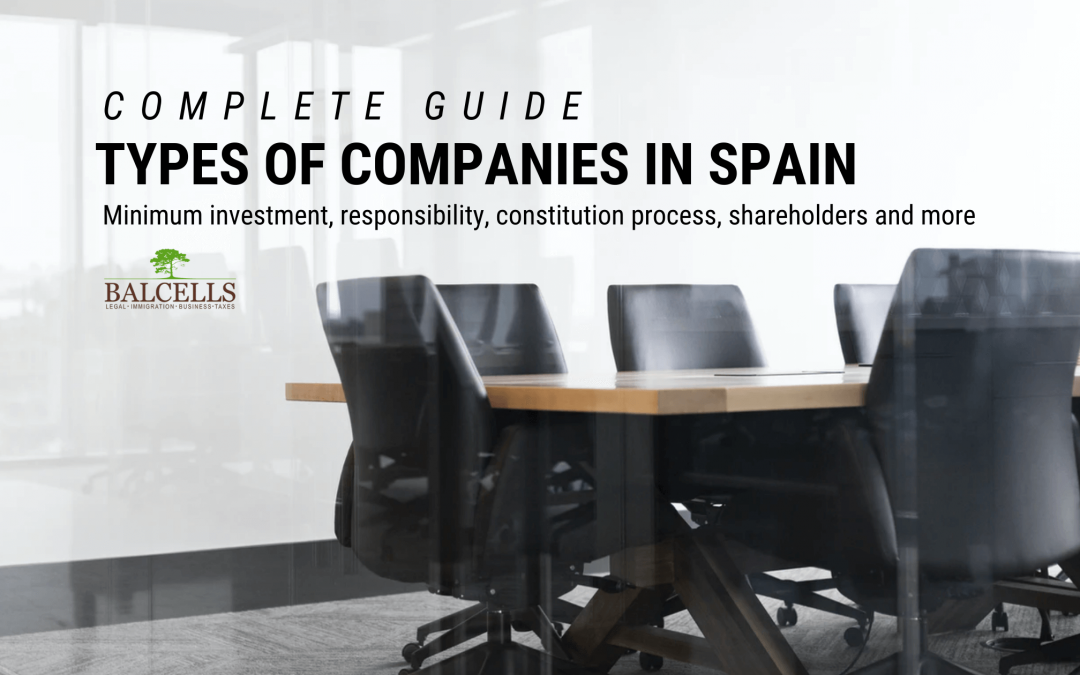When you realize that there are more than 10 types of companies in Spain, choosing the ideal entity for you is not an easy task. However, in this article we make it easy for you. We will navigate through the different types of business structures within the Spanish territory. For each one of them, we will see the most relevant information you really need when choosing one: minimum capital investment, number of shareholders, advantages and disadvantages, taxes, and much more.
General classification
In Spain, we find different types of companies. In later sections we will see each one of them in full depth, but having a general context before that will be very useful for us.
On a general level, we can classify them into two large groups according to their personality:
Individual companies
Individual companies have a non-legal personality, being owned by an individual. Within this grouping, we find two types of companies:
- Sole trader (self-employed or “autónomo”)
- Private civil society (partnership)
Corporate companies
The main difference, in this case, is that we are talking about a legal personality, and not a physical one; that is, the company has a personality of its own and different from that of its owners or partners.
Another important difference is that all corporate companies must be registered in the Commercial Registry and formalized by public deed.
We find three different typologies, which in turn contain the different most common company structures:
- The public civil society.
- Commercial companies; such as the collective, limited partnership, limited partnership by shares, limited liability company, newly created limited liability company, joint-stock company and the labour one.
- Cooperatives
What are the different types of companies in the Spanish territory?
Let’s dive into the different types of business structures or companies in Spain. We will analyze each one of them from the main key elements that will help you make the decision of which is the best type for you.
As you will see, the rigid and hierarchical management culture in the country is also reflected on the legal structures available for business owners.
Sole trader (autónomo o empresario individual)
The simplest entity and at the same time one of the most common structures in the Spanish territory.
The sole trader or “autónomo” is a company that is equivalent to the worker, who carries out the activity under its own name. This owner-worker has total control of the company, directing and managing it.
One of its main advantages is the simplicity of procedures and registration process.
In general, if you are going to offer services as an independent professional or freelance; whether you offer digital marketing services, services as a painter, or any similar, this business form is the one most recommended.
Liabilities
Company liabilities are unlimited. In other words, the self-employed individual is responsible for any debt with third parties with all his or her assets, present and future.
Minimum investment
One of the reasons that make the structure as a self-employed one of the simplest is that there is no need for a minimum investment. You can start your business without having a single euro in your bank account.
Company name
The name of the company is the same as that of the sole trader. Your tax identification number, therefore, is equivalent to your NIE or DNI.
Taxes
The self-employed are taxed through the IRFP or income tax, as the company profits are considered individual. In addition, he must submit his VAT returns quarterly, a tax that he will include when invoicing.
Here you can find a complete guide explaining how self-employed taxes work.
Set up process
To register as a self-employed worker, you must basically follow the next steps:
- At the Tax Office, register your IAE (economic activities tax), indicating the epigraph of your activity.
- Register with Social Security as a self-employed worker.
- Start operating.
It’s that easy!
Jointly owned company (comunidad de bienes)
A jointly owned company is an equivalent type to the previous case, with the only difference that in this case the business ownership is divided between two or more people.
There is no minimum investment and personal income tax is paid individually.
The second important difference can be found in the set up process, which is a little longer:
- First of all, you need to create a constitution contract, which is an agreement between the different partners.
- Afterwards, a tax identification number or CIF is requested.
- Register with IAE.
- Finally, social security registration.
Private partnership (sociedad civil privada)
A private partnership or private civil society is an agreement between two or more individuals whereby they contribute any kind of investment to the company (whether goods, time/work, assets of any kind, etc.), in exchange for a share in the profits generated by the company.
A clear example is music festivals, which bring together different partners for a specific period of time to finance and manage the event. Once finished, the activity ceases until next year.
Thus, the private partnership lasts as long as what has been agreed upon by the contract.
Liabilities
The liability is unlimited and personal against third parties; but attributable to each partner individually.
Minimum investment
One of the main advantages of this type of structure is that there is no minimum investment.
Company name
The company name can be chosen by the partners; with total freedom as long as it is not already taken.
Taxes
It is taxed by income tax, again, since the partners act as individuals and the profit is considered individually.
Set up process
If you want to make it official (it is not compulsory), you must first create a private document or incorporation contract, which must be signed before a notary
Finally, registration in IAE and social security.
Limited liability company or SL (Sociedad Limitada)
The limited liability company or SL is the most widely used type of company in Spain due to its characteristics. They tend to be SMEs (PYMES) as they have few partners and the initial investment is very low.
Liabilities
Shareholder/partner liabilities, as the name itself indicates, is limited to the capital contribution made by each of them.
Minimum investment
The minimum investment is 3,000 euros. One of the great advantages of the limited liability company is that this investment can be made through cash or money in a bank account, but also through assets that will be used for the business activity (e.g. company telephone).
However, the initial capital must be 100% subscribed and paid upfront at the time of the constitution.
This share capital is divided into shares (and not publicly traded stocks).
The number of partners when constituting an SL is one or more than one, hence we can find sole proprietorships.
Company name
The company name will be the name of the company (which you’ll need to verify is not already being used), followed by “sociedad de responsabilidad limitada” or “sociedad limitada”; or its acronym “SRL” or “SL”.
Taxes
In this case, it is subject to corporate income tax; and there is the possibility of benefiting from deductions and receiving allowances.
Set up process
The constitution process consists of the following steps:
- First, the creation of the statutes and the document of incorporation, signed before a notary
- Registration in the Commercial Registry.
- Application for the business tax identification number or CIF.
- Registration with IAE and social security (for all employees).
For more details on how to set up your limited company in Spain, this article will be very useful.
Liquidation
This is something that you will certainly try to avoid at all costs, but in many cases companies must come to an end (or be liquidated). 1 in 10 new businesses fails, so knowing in advance how the dissolution process works will be key. In this article you will find how to dissolve and liquidate an SL step by step.
Newly created limited liability company
The newly created limited liability company is a simplified form of the previous mercantile structure, created to simplify procedures and to offer the possibility to create a microenterprise as quickly as possible.
In that sense, it is possible to have your company legally set up and active in only 48 hours.
Minimum investment
The minimum investment, like the SL, is 3,000 euros. However, in this case, we also find a maximum of 120,000 euros.
The number of shareholders at the time of constitution is limited to a maximum of 5, who must be non-legal individuals. It is also allowed to be a single person (a single partner).
After the constitution, this number of members can be increased by transferring shares.
Company name
The company name is the surname and first name of one of the partners plus an alphanumeric code (composed by letters and numbers).
In addition, you must start “sociedad limitada nueva empresa” or its abbreviation “SLNE”.
Taxes
It is also taxed through the corporate tax system, although in this case, it receives tax and accounting benefits (simplified system).
Set up process
The constitution process is the same as the limited one, with very simple steps done via the internet.
Stock corporation or Public Limited Company or (Sociedad Anónima, SA)
The stock corporation is a highly regulated and broad structure, ideal for large listed companies.
So much so that it requires annual accounts and periodic inspections.
The company’s capital is divided into shares, which can be either registered or bearer shares, and can be freely transferred.
Liabilities
Shareholders have limited liability against debts.
Minimum investment
The minimum investment of 60,000 euros, being the company type that requires a higher amount of initial capital.
This initial investment can be provided simultaneously (all at once) or successively (with partial disbursements).
The number of partners or shareholders for the incorporation can be one (sole proprietorship) or more than one, either non-legal or legal persons.
Company name
The company name is formed by the name of the company (chosen freely) followed by “sociedad anónima” or “s.a.” or “SA
Taxes
It is taxed by way of corporate tax, which is 25% of company profits.
Set up process
The constitution process is a little longer than in previous cases:
- First, the company’s statutes are created; they contain the name, share capital, address, number of shares with which the capital is divided, business organization, and other agreements.
- The CNN (negative certification of the name) is then consulted to verify that no other company has the name we want to use.
- Then we proceed to the registration in the Commercial Registry
- CIF is requested
- IAE registration
- Social security registration (for all workers who will be working)
- Fulfillment of other obligations according to the autonomous community
Worker-owned company (Sociedad laboral)
The worker-owned company is a special type of public limited company (SA) or limited liability company (SL). In other words, it can take either of the two forms.
Its main feature is that its shares, and therefore the ownership of the company, are held by two different groups:
- The working class (the workers), who have a minimum of 51% of the shares.
- The general class those who do not work directly for the company.
In this regard, no shareholder may hold shares or participations (depending on the business structure chosen) representing more than one-third of the capital (33%) so as not to reach absolute majorities, with the exception of public entities, which may reach up to 49%.
A special mandatory reserve fund of 10% of the profit obtained during the financial year must be set up.
Responsibility
Liability is limited to the capital contributed.
Minimum investment
The same as an SA (60,000 euros) or SL (3,000 euros), depending on the type of company chosen.
The minimum number of partners is 4, of which three must be working partners.
The workforce owned company may also have employees who are not shareholders.
Company name
The corporate name or name is formed by any name followed by “sociedad de responsabilidad limitada laboral” or “sociedad anónima laboral”, or the respective initials “SRLL” or “SAL”.
Taxes
It is subject to corporate tax.
Set up process
In this case, before registering for IAE and social security, the company must be entered in the “Registro of sociedades laborales” at the Ministry of Work and Affairs and then in the Companies Registry.
Cooperative (Sociedad cooperativa)
A cooperative is a group of legal and non-legal individuals that develop a business activity (non-profit) and with social purposes. The profits are used to cover the needs of the company and its operation; and the surplus (not the profits) are distributed to its members, but once these common funds have been covered.
Thirty percent of the surplus is to be allocated to a mandatory reserve fund and a specific fund for education and promotion activities.
There are two types of cooperatives:
- Grade one (usually with 3 members, which can be individuals and/or companies)
Grade two (two or more cooperatives, which are usually legal entities)
Liabilities
Members of a cooperative society’s liabilities are limited to their contribution; however, the statutes can be modified to make it unlimited.
Minimum investment
The minimum investment will be defined in the statutes and will vary according to the number of members. However, none of them may hold more than 25% of the capital in first degree cooperatives, and no more than 45% in second-degree ones.
From 2 to 5 initially, although it will vary according to the cooperative.
Taxes
Cooperatives pay corporate tax but with certain tax advantages due to their type of company.
Set up process
The constitution process is somewhat different from what we have been seeing so far:
- First of all, you need to ask for a naming certificate from the “Sección Central del Registro de Cooperativas“, to verify that the name chosen is not already in use.
- Then the statutes are created and signed before a notary.
- Public Deed of Incorporation
- Register it in the Register of Cooperatives
- CIF is requested
- Registration in the IAE and social security
General partnership (Sociedad colectiva)
The general partnership is ideal for a business project with a small number of partners. All of them are involved in the management of the company, although if they only contribute with work (and not capital), they cannot participate in the management.
Liabilities
Although at the legal entity level it is different from the partners, the responsibility is unlimited; since the partners respond to the debts against third parties in a personal manner.
This means that the entire debt can be claimed to any/each of the partners.
Minimum investment
There is no minimum share capital for incorporation.
The constitution requires a minimum of 2, but there is no maximum.
Company name
The name of the company should include at least one of the partners, but ideally all of them. If not all of the names are used, the “y compañía” tag should be added. In all cases the words “sociedad colectiva” or “SC” should be added.
Taxes
They pay corporate tax at the usual rate.
Limited partnership (sociedad comanditaria)
There are two types of limited partnership:
- The simple one, which is personal, managed by the partners on a mandatory basis.
- And the one by shares, which is a capitalist society, in which the shares have more weight and the management does not necessarily fall to the partners.
Liabilities
Liabilities depend on the type of partner, which in both cases (limited partnership and joint-stock partnership) can be:
- General partners, personally and unlimitedly liable for debts, intervening directly in the management of the company.
- Limited partners, who, after making a financial contribution, do not intervene in the management of the company but do participate in its results. Their liability is therefore limited against third parties.
Minimum investment
There is no minimum initial capital required, making it an attractive option.
The minimum number of partners is 2, of which one must be a collective partner and the other a limited partner.
Company name
The company name must consist of the name of all the general partners followed by “sociedad en comandita” or “s. en c.” or “s. com.
The name of the limited partners can never appear in the name of the company.
Taxes
Corporate tax.
Set up process
Constitution process the same as SA but with its specific agreements.
Branch office
In case you already have your company abroad and would like to start operating in Spain, a branch office can be a much better option than opening an S.L.
One of its main advantages is that there is no minimum amount of social capital required for its constitution, and it does not have to file yearly accounting statements (as the parent company will).
The branch office is fully dependent on the corporate one, and hence has no responsibility against tax fines or employee payments.
You can learn more about the advantages of branch offices and its constitution process here.
Do you need help choosing the ideal type of company for you?
So far we have seen all the different types of firms and business structures in Spain.
Although we have analyzed the main points on which you should base your decision, it is very likely that you still have doubts.
Depending on your particular situation and interests, a business structure may be much more interesting and suitable than the rest. And we want to help you find it.
Simply reach out, and our team of business lawyers will give you the advice you need.
Book a consultation with one of our lawyers and solve all your doubts:

At Balcells Group we have been foreigners effortlessly moving to Spain for over 11 years. We help expats from all around the world with their immigration, business, tax and legal needs; ensuring a legally safe and enjoyable transition to the Spanish territory. Our multilingual team understands the importance of adapting to the cultural and legal specificities of our international clients. We offer a comprehensive service that combines the expertise of several generations of lawyers with the innovation needed to address today’s legal challenges, always striving to simplify processes and ensure reliable, effective results.



